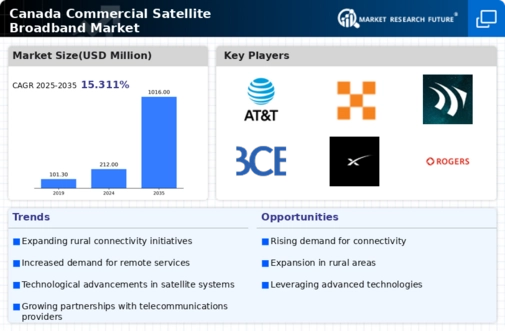Rural Connectivity Demand
The demand for enhanced connectivity in rural areas of Canada drives the commercial satellite-broadband market. Many remote regions lack reliable internet access, which hampers economic growth and social inclusion. As of 2025, approximately 25% of rural Canadians still experience inadequate broadband services. This gap creates a significant opportunity for satellite providers to offer solutions that bridge the digital divide. The commercial satellite-broadband market is poised to benefit from government initiatives aimed at improving connectivity, as well as private investments targeting underserved areas. The increasing reliance on digital services in agriculture, education, and healthcare further fuels this demand, suggesting a robust growth trajectory for satellite broadband solutions in rural Canada.
Increased Mobile Data Consumption
The surge in mobile data consumption among Canadians is a critical driver for the commercial satellite-broadband market. With the proliferation of smartphones and IoT devices, data usage has escalated dramatically, with average monthly data consumption reaching over 10 GB per user in 2025. This trend necessitates reliable and high-speed internet access, particularly in areas where terrestrial networks are insufficient. Satellite broadband offers a viable alternative, providing coverage in remote locations where traditional infrastructure is lacking. As businesses and consumers alike seek uninterrupted connectivity for streaming, remote work, and online services, The commercial satellite-broadband market is likely to see increased investment and innovation to address these growing demands.
Emerging Applications in Various Sectors
The emergence of new applications across various sectors is propelling the commercial satellite-broadband market forward. Industries such as agriculture, mining, and transportation increasingly rely on satellite connectivity for real-time data transmission and operational efficiency. For instance, precision agriculture utilizes satellite data to optimize crop yields, while mining operations depend on remote monitoring systems that require robust internet access. The commercial satellite-broadband market is expected to expand as these sectors adopt advanced technologies that necessitate reliable connectivity. As of 2025, the integration of satellite broadband into these applications could potentially enhance productivity and reduce operational costs, indicating a promising outlook for the market.
Regulatory Support for Satellite Services
Regulatory frameworks in Canada are evolving to support the growth of the commercial satellite-broadband market. The Canadian Radio-television and Telecommunications Commission (CRTC) has implemented policies aimed at fostering competition and innovation in the broadband sector. These regulations encourage investment in satellite technologies and infrastructure, which is crucial for expanding service availability. Furthermore, the government has allocated funding to initiatives that promote satellite broadband as a solution for underserved communities. This regulatory support not only enhances market confidence but also stimulates partnerships between satellite providers and local governments, potentially leading to increased market penetration and service diversification.
Technological Innovations in Satellite Systems
Technological innovations in satellite systems are transforming the commercial satellite-broadband market. Advancements such as high-throughput satellites (HTS) and low Earth orbit (LEO) constellations are enhancing bandwidth and reducing latency, making satellite internet more competitive with terrestrial options. As of 2025, the deployment of LEO satellites is expected to revolutionize connectivity, particularly in remote areas of Canada. These innovations enable faster data transmission and improved service reliability, which are critical for both consumers and businesses. The commercial satellite-broadband market is likely to experience accelerated growth as these technologies become more widely adopted, offering enhanced user experiences and expanding service capabilities.























Leave a Comment